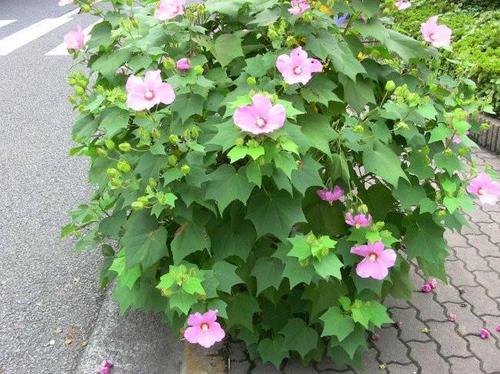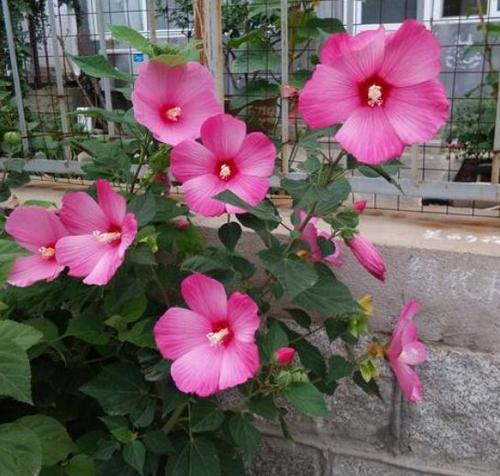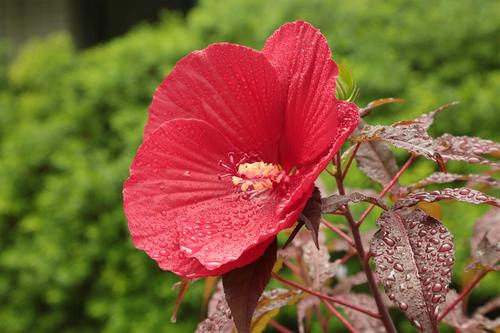Hibiscus profile
Written by Maggie
Apr 27 2021

Hibiscus is also known as mallows, swamp mallows. Hibiscus is a hybrid of hibiscus sunflower, native to the eastern United States, and the same species. Hibiscus is a perennial herb. Flowers are up to 20-30 cm in diameter, white, light red, red rose to deep red. Flowering in summer and autumn.
Hibiscus picture

Hibiscus info
| Botanical Name | Hibiscus moscheutos |
| Common Name | Hibiscus, rose mallows, swamp mallows |
| Plant Type | Herbaceous perennials |
| Mature Size | 3 to 7 feet tall and 2 to 3 feet wide |
| Sun Exposure | Full sun |
| Flower Color | White, red, pink, blue |
| Hardiness Zones | USDA 4-9 |
| Native Area | Eastern North America |
The morphological characteristics of Hibiscus
Hibiscus linearly roots are developed, up to 50-60 cm deep. The vertical roots of the transplanted seedlings are easily injured, while the horizontal roots grow more prosperous, and the root length can reach about 1 meter.
There are few fibrous roots and lateral roots of Hibiscus, and the roots are light brown yellow, brittle and easily broken. The branches are semi-lignified herbaceous. Racemose branch, because different varieties plant height is 50-100 cm, branch skin is smooth, dark flower branch, branch new tip ministry is purple, light color variety is green, slightly covered with white powder. Branching strength is strong, almost all leaf buds can germinate into lateral branches when the ventilation and light permeability conditions are better.
Single leaf of Hibiscus is alternate, leaf inflorescence 2/9, leaf apical ovoid, leaf margin obtuse serrate. The petiole is long and the leaf surface is smooth. The new leaves are shiny and the old leaves are rough. Leaf back of Hibiscus is without fuzz, dull, veins thick and obvious. The veins on the leaf surface are sunken, the veins on the back of the leaf are raised, same as the tender shoots. The veins of the dark flowers and young leaves are partly purplish red, and the rest are white. The flowers are enormous, with corolla diameters ranging from 25 to 30 cm for each species. Too late autumn or flowering too much plant growth potential is weak, flower diameter also has about 20 cm.
The color of Hibiscus is bright, deep purple, peach, pink, light pink, white, filament is long and thin, the base is united into a stamen column, and the base of petals is combined.
Ecological habits of the Hibiscus
Hibiscus has strong adaptability, resistance to cold and drought, and can survive the winter well in wetter conditions. Extremely resistant to high temperature and insolation, Hibiscus blooms exuberantly under 36℃ and scorching sun in the Beijing area. It is a promising perennial root flower of Beijing Wangxia.
Hibiscus is not strict with the soil.But the looser sandy loam is better. Iron deficiency is predisposed to occur in soils that are too alkaline. The level of soil fertility is not high, and it can still grow and blossom normally under the condition of three years of continuous cropping without any base fertilizer or top dressing.
The Hibiscus distribution area
Hibiscus is a hybrid of hibiscus sunflower, native to the eastern United States, and the same species.Flowers are up to 20-30 cm in diameter, white, light red, red rose to deep red. Flowering in summer and autumn.
How to grow and care for Hibiscus
Light
For your hibiscus plant to bloom to its best potential, it desires about six hours a day of full sun. However, if you stay in a warm and dry quarter you have to furnish your hardy hibiscus occasional remedy from the shiny afternoon sun. Shade from different leafy flowers positioned close by must help. Indoor hibiscus plant life has to be located close to a sunny (southwest facing) window and if that nevertheless does not grant adequate light, you can increase with synthetic lighting.
Soil
The Hibiscus is a wetland plant, and hardy hibiscus flora can be handled as flora for moist soils. So if your landscaping scenario is a soggy region where most vegetation no longer develops well, H. moscheutos would possibly be the answer. This makes them beneficial round water features.
Water
If you are no longer planting hibiscus flora in a moist spot, make positive they are appropriately watered—but do not overdo it. A small plant with fewer leaves desires much less water than a giant leafy plant. In heat weather, you want to water your hibiscus plant every day however in the wintry weather you must water it solely when the soil is dry to the touch.
Temperature and humidity
Hibiscus flower quality in the 60 to ninety F range. Bring vegetation indoors earlier than temperatures dip to 32 F, however be aware that low humidity can dry them out. Mist the leaves every day or vicinity every pot on a tray with a layer of gravel underneath. Add water up to the pinnacle of the gravel and as it evaporates, the humidity will upward jab round the plants. A humidifier may also additionally help.
Fertilizer
Growing hibiscus vegetation wants lots of nutrients. Use both slow-release or water-soluble fertilizer however make positive the vitamins are balanced. For example, use a 20-20-20 or 10-10-10 fertilizer. You can use a diluted liquid fertilizer as soon as a week, or a slow-release fertilizer 4 instances a year: early spring; after the first spherical of blooming; mid-summer; and early winter.
Potting and repotting
Repot in late iciness and use houseplant potting soil or a soilless mixture. Your hibiscus can wait two to three years to be moved into a large pot. Just understand to use one with proper drainage.
Pruning
Since this perennial dies lower back to floor degree in winter, you can prune it down to the floor in fall. As alive as the branches may additionally appear in fall, they will die in winter. But the root gadget will stay on and new branches will spring out of the floor the following year.

Varieties of Hibiscus
For big, show-stopping flowers, you will choose to develop a cultivar of H. moscheutos, such as one of the following:
Lady Baltimore: Four to 5 toes tall and three toes wide; plants are mild red with a deep red center.
Robert Fleming: Three ft tall and 4 ft wide; flora are deep, velvety purple and ruffled.
Summerific Perfect Storm: Three toes tall and 5 ft wide; vegetation are mild red with a deep red center.
Growing Hibiscus in containers
If you are developing hibiscus in a container, be positive to plant it in a pot with enough drainage holes. Over-saturation of the roots will reason them to rot.
Propagation of Hibiscus
Hibiscus, except the main stem, mostly on the lateral branches of flowering, racemose inflorescences, flowers from the bottom to open continuously. Single flowering period of a day, but an inflorescence can continue to bloom for 20-25 days, the growth of flourishing can open to more than 30 days, after an inflorescence, the following side buds continue to germinate, the top of the inflorescence, still can bloom, until late October after the early frost, the flowering period is terminated. More than two years of plants, from the rhizome sprouted adventitious buds, generally biennial can sprout 3-5 branches, three years can reach 5-7 branches, more than 10 branches. When the branches sprouted too much, the single branches became weak, and some of the sprouted branches lost the ability to form flower buds because of excessive shading. The diameter of a single plant can reach 60 cm for more than two years. The large flowering okra is a long-daylight-loving plant, which cannot form flower buds and bloom under short sunshine conditions.
Uses of Hibiscus
Hibiscus is a flower border plant with a very high appreciation effect.

Latest Updated
- Benefits of Bugleweed - 7 Science-backed Health Benefits
- Bugleweed Dangers & Side Effects - Is It Poisonous?
- How to Plant Evergreen Trees - What You Should Know
- When to Plant Evergreens - Grow Guide for Evergreen Trees
- 12 Wonderful Evergreen Shrubs for Your Garden
- 12 Popular Evergreen Plants with Pictures for Beginners
- When And How To Prune A Lilac Bush Like a Pro
- How to Grow & Care for Lilac Vine (Hardenbergia Violacea)
- Japanese Lilac Tree (Syringa Reticulata) Care & Propagation Guide
- Shumard Oak Pros and Cons - What to Know
Popular Articles
- Winter maintenance of Antirrhinum Majus
- How to Grow Terminalia Mantaly Tree
- How to Grow and Care for Crossostephium Chinense
- How to grow Antirrhinum Majus in spring
- Peristeria Elata (Dove Orchid) Profile: Info & Care Guide
- Underwatered Snake Plant (Sansevieria Trifasciata) - Signs And How To Fix
- How to Care for Brazilian Jasmine Plant (Mandevilla Sanderi)
- How to Grow & Care for Graptopetalum Purple Delight in Summer
- Rosa Chinensis (China Rose): Plant Growing & Care Tips
- How to Care for Baby Sun Rose (Aptenia Cordifolia)